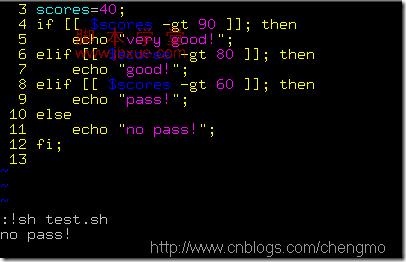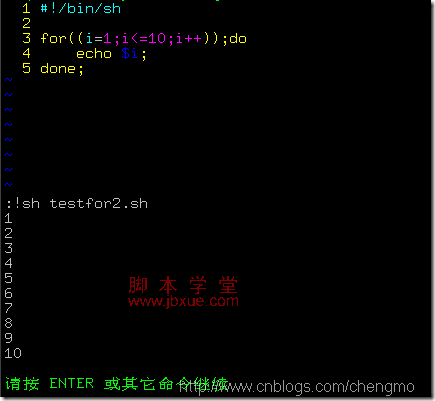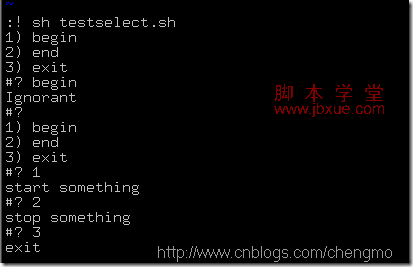一、shell条件语句(if用法)
if语句结构[if/then/elif/else/fi]
if 条件测试语句
then
action
[elif 条件
action
else
action
]
fi
如果对于:条件测试语句不是很清楚,可以参考:linux shell 逻辑运算符、逻辑表达式详解
shell命令,可以按照分号分割,也可以按照换行符分割。如果想一行写入多个命令,可以通过“';”分割。
例如:
[chengmo@centos5 ~]$ a=5;if [[ a -gt 4 ]] ;then echo 'ok';fi;
ok
实例:(test.sh)

条件测试有:[[]],[],test 这几种,注意:[[]] 与变量之间用空格分开。
二、循环语句(for,while,until用法):
1.for循环使用方法(for/do/done)
语法结构:
1.for … in 语句
for 变量 in seq字符串
do
action
done
说明:seq字符串 只要用空格字符分割,每次for…in 读取时候,就会按顺序将读到值,给前面的变量。
实例(testfor.sh):

seq 10 产生 1 2 3 。。。。10空格分隔字符串。
2.for((赋值;条件;运算语句))
for((赋值;条件;运算语句))
do
action
done;
实例(testfor2.sh):

3.while循环使用(while/do/done)
while语句结构
while 条件语句
do
action
done;
实例1:
#!/bin/sh
i=10;
while [[ $i -gt 5 ]];do
echo $i;
((i--));
done;
运行结果:========================
sh testwhile1.sh
10
9
8
7
6
实例2:(循环读取文件内容:)
#!/bin/sh
while read line;do
echo $line;
done < /etc/hosts;
运行结果:===================
sh testwhile2.sh
# Do not remove the following line, or various programs
# that require network functionality will fail.
127.0.0.1 centos5 localhost.localdomain localhost
4.until循环语句
语法结构:
until 条件
do
action
done
意思是:直到满足条件,就退出。否则执行action.
实例(testuntil.sh):
#!/bin/sh
a=10;
until [[ $a -lt 0 ]];do
echo $a;
((a—));
done;
运行结果:
sh testuntil.sh
10
9
8
7
6
5
4
3
2
1
0
三、shell选择语句(case、select用法)
1.case选择语句使用(case/esac)
语法结构
case $arg in
pattern | sample) # arg in pattern or sample
pattern1) # arg in pattern1
*) #default
esac
说明:pattern1 是正则表达式,可以用下面字符:
* 任意字串
? 任意字元
[abc] a, b, 或c三字元其中之一
[a-n] 从a到n的任一字元
| 多重选择
实例:
#!/bin/sh
case $1 in
start | begin)
echo "start something"
stop | end)
echo "stop something"
*)
echo "Ignorant"
esac
运行结果:======================
testcase.sh start
start something
2.select语句使用方法(产生菜单选择)
语法:
select 变量name in seq变量
do
action
done
实例:
#!/bin/sh
select ch in "begin" "end" "exit"
do
case $ch in
"begin")
echo "start something"
"end")
echo "stop something"
"exit")
echo "exit"
break;
*)
echo "Ignorant"
esac
done;
运行结果:

说明:select是循环选择,一般与case语句使用。
以上介绍了linux shell中流程控制语句的用法,其中包括条件语句(if),循环语句(for,while),选择语句(case),希望对大家有所帮助。